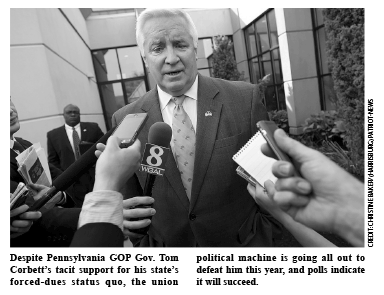Right to Work on State Legislators’ Agenda
Bans on Forced Union Dues Expected to Come up For Roll-Call Votes (Source: the January 2015 National Right to Work Committee Newsletter) With the vast majority of state legislatures across the…

Bans on Forced Union Dues Expected to Come up For Roll-Call Votes (Source: the January 2015 National Right to Work Committee Newsletter) With the vast majority of state legislatures across the…

State Groups Bolstered by Recent Victories in Indiana, Michigan (source: October 2014 National Right to Work Committee Newsletter) This fall, members of grass-roots groups based in states as diverse as Montana, Kentucky,…

Taxpayers Suffer Dearly, But Most Public Servants Benefit Little (Click here to download the July 2014 National Right to Work Committee Newsletter)…
The needle & the damage done | TribLIVE Recent elections for state legislative and executive offices have not been favorable, to say the least, for Big Labor political operatives and their allied politicians in Pennsylvania. Republican Gov. Tom Corbett was elected in 2010 despite…
Blogging for National Review Online late last week (see the link below), the Heritage Foundation’s James Sherk furnished an especially outrageous example of how Big Labor often wields its government-granted monopoly bargaining power in ways that hurt employees economically. Big…

If you live in the following states, Colorado, Florida, New Hampshire, Nevada, Ohio, Pennsylvania, Wisconsin and Virginia, you will have the privileged of seeing millions of dollars of forced union dues money spent to re-elect President Obama. The Service…

If you live in the following states, Colorado, Florida, New Hampshire, Nevada, Ohio, Pennsylvania, Wisconsin and Virginia, you will have the privileged of seeing millions of dollars of forced union dues money spent to re-elect President Obama. The Service…

(Source: March 2011 NRTWC Newsletter) Millions Have 'Voted With Their Feet' For Better Opportunities For a combination of reasons, nationwide the number of young adults aged 25-34 is growing far more slowly than is the number of Americans aged 55 and older. In 1999, according to the U.S. Census Bureau, there were 37.94 million people aged 25-34 living in the U.S. By 2009, there were 41.57 million people nationwide in that age bracket. That's a 9.6% increase. Over the same decade, the number of Americans aged 55 and older soared from 57.93 million to 74.36 million, a whopping 28.4% increase! The nationwide decline in young employees' population share, relative to that of Americans nearing or in their retirement years, is obviously an impediment to economic growth. Eleven Non-Right to Work States Suffered Young-Adult Population Declines

(Source: December 2010 NRTWC Newsletter) In every region of the country where both Right to Work states and forced-unionism states are located, the Right to Work states' long-term economic growth is superior. The Midwestern contrast is especially strong. Legislators Look at 'Oklahoma Model' For Stronger Economic Growth It's been more than seven decades since The Grapes of Wrath, both the John Steinbeck novel and the Hollywood movie it inspired, established the desperate migration of "Okies" from the Dust Bowl to the orchards of California as an icon of the Great Depression. Times have certainly changed. As an October 12 USA Today feature story noted, since 1999, "the number of Californians departing the Golden State for Oklahoma has outnumbered those going the opposite direction by more than 21,000 . . . ." The net influx of people into the Sooner State from California and many other states with sub-par or abysmal job and income growth records is, as USA Today put it, "a sign of Oklahoma's growing economic prowess." To explain the state's recent record of economic success, the USA Today feature specifically mentioned Oklahoma's low and relatively stable housing costs, its concentration of aerospace and defense technology expertise, and its oil and natural gas reserves. But as important as these assets are, Oklahoma had them all in the early 1990's, when its long-term job and income growth still trailed the national average. The real turning point for Oklahoma's transition from an economic laggard to an economic leader was in 1992 -- when the National Right to Work Committee teamed up with local grass-roots activists to map out a multi-year campaign to pass a Sooner Right to Work law. Benefits of Right to Work Campaign Were Evident Long Before State Law Was Passed "In the early 1990's, the 'Dust Bowl' was already a distant memory, but Oklahoma's job climate still seemed pretty dry," commented Matthew Leen, vice president of the National Right to Work Committee. Domestic population migration data reflect Oklahoma's "growing economic prowess." The 1994-2001 Sooner State campaign to pass a Right to Work law, as well as the law itself, helped build that prowess. "From 1984 through 1994, the decade before the Committee program to pass a Right to Work law in Oklahoma was initiated, private-sector employment in Oklahoma increased by less than a third as much as the national average, according to the U.S. Labor Department. "Over that same decade, inflation-adjusted U.S. Commerce Department data show Oklahoma's real personal income grew by just 2.3%, less than a tenth of the nationwide percentage gain. "But in 1994, the seeds of change were